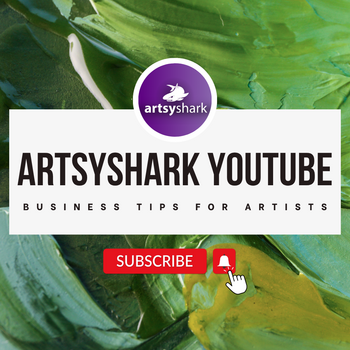by Carolyn Edlund
As an artist, your story is an integral part of your work and the experience that your collectors have. Here’s how to create it, and share it.

Telling your artist story is an effective method of making that important connection to your audience. When a collector makes a purchase, they aren’t just acquiring a thing; a work of art is more than just a product. It contains a piece of your creative spirit, talent and inspiration, and your story is one way that you convey that spirit. Often, collectors will tell your story when they show the art they own to friends or family.
Writing about yourself as an artist is an essential first step in building your story. Write down a long version first, including everything you believe is important. Then, pull out highlights and story elements that you feel will resonate with your audience. Some information that you might want to include:
- Your inspiration to create art
- The process you use in creating your work
- The subject matter you chose to depict
- The message in your work
- Your background or personal history that relates to your body of work
Where can you share your story?
1. On the About page of your website. This is the perfect place to print your story, because it is one of the most-visited pages on any site. Include your photo here as well, so you visitors feel they know you.
2. In posts on your blog. Artists are fascinating to most people. Your inspiration, studio practice and lifestyle makes terrific content for a blog article. In each post, share something new and interesting about yourself and your art.
3. In interviews you give to publications. You’re newsworthy! Writers for magazines and newspapers are always looking for interesting stories to share with their readers. Here’s where your long story can come in handy. Want to get press coverage? Learn more here.
4. In press releases and press kits. These marketing methods are all about the story. Get tips on writing a press release here and putting together an effective press kit here.
5. In your newsletters and individual emails. Your monthly email marketing campaign will share information about you and your work on an ongoing basis. One of the primary purposes for these campaigns is to get prospective customers to know, like and trust you. Your story is an essential part of this.
6. When speaking to an audience about your work. Got an opportunity to give a talk, perhaps at a gallery or event? Your story can be the basis of a fascinating presentation that draws your audience in. Learn more about public speaking here.
7. While meeting customers in person at a retail event or a gallery show. Meeting potential collectors face-to-face is one of the best ways to connect with them. Listen to them, and learn more about who they are. And, speak with them, sharing who you are as an artist and what you are passionate about.
8. On booth signage at events where you are selling. Narrow down your story to a few words, and you’ve got a perfect line for a banner or sign to draw them in.
9. In your brochure, hangtags and other collateral. Anything printed that represents your business is a space where elements of your story can be told. Whether it’s a few paragraphs in a trifold brochure, or a sentence on a hangtag, use that space to reinforce the story of your business and your brand.
10. On social media pages such as Facebook and Instagram. Social media is where lots of networking happens, and relationships can be built. It lends itself beautifully to a narrative, where you can add to your story, and start conversations.




This is a beautiful article as I have been thinking about the same for a while. But writing something that other people may find interesting about artists is not as simple, in my opinion. And how far do you go, as not all personal stories could be interesting to others? I think the key here is to link your story events to the artist’s work rather than a general life story. I would be interested to hear others views on the subject. Thank you for the article.
Thanks for your comment, Suhail, and I think you are absolutely correct. Not everything about your personal story is interesting or even appropriate to share. I suggest you consider how your art touches others, what you have in common with your fans, or emotionally “connectable” topics such as overcoming adversity, sending a positive message or celebrating life and nature, if that applies to your work.